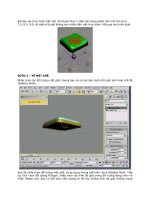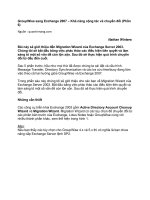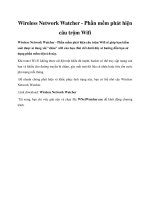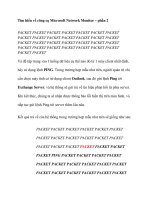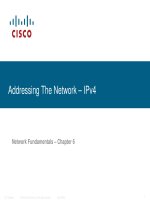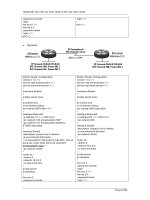TEAM FLY WIRELESS NETWORK DEPLOYMENTS phần 6 pdf
Bạn đang xem bản rút gọn của tài liệu. Xem và tải ngay bản đầy đủ của tài liệu tại đây (543.24 KB, 25 trang )
126
Chapter 6
where is the carrier frequency, is the input complex magnitude, and
and represent the gain and phase characteristics of the PA. The phase
distortion term is to represent the AM to PM effect seen in many nonlinear
devices. These functions can normally be derived from a single-tone test,
where the effects of PA distortion on a singular frequency are captured. In
[11], the authors demonstrate that by using this model, they were able to
effectively simulate their two-stage gallium-arsenide MESFET amplifier and
demonstrate the device’s compliance with emission requirements for PCS
CDMA.
Due to gain and phase distortion, spectral re-growth results in at the
output of the PA. This is troublesome due to the need to meet specific
electromagnetic compatibility requirements. Moreover, input stages to the
PA, which provide spurious products will contribute difficulty in meeting the
required spectral emissions mask.
4. CONCLUSIONS
Intermodulation distortion in IS-95 handset transceivers is particularly
troublesome for both reception and transmission. However, if one can
isolate the source of the interference resulting in intermodulation, one can
compensate for this in either the receive or transmit paths. For the receiver,
accurate detection of the presence of intermodulation is important. Once this
is achieved, then appropriate action may be taken to ensure that
intermodulation products do not capture the receiver. For the transmitter,
intermodulation compensation may be accomplished by IQ-balancing and
DC-offset compensation.
REFERENCES
[1]
TIA/EIA/IS-95-A: Mobile Station-Base Station Compatibility Standard for Dual-Mode
Wideband Spread Spectrum Cellular System. The Telecommunication Industry
Association.
Intermodulation Distortion in CDMA Handsets 127
[2]Hamied, Khalid and Gerald Labedz. "AMPS Cell Transmitter Interference to CDMA
Mobile Receiver." IEEE Vehicular Technology Conference. May, 1996. pp. 1467-1471.
[3] Joyce, Timothy. “Field Testing of QCP800 Phones in High Analog Interference
Conditions.” Ameritech Report. March, 1996.
[4]Shen-De, Lin, et.al. “Impact of CDMA Mobile Receiver Intermodulation on Cellular 8
Kbps System Performance.” Lucent Technologies Report. February, 1996.
[5] Kazakos, D. and P. Papantoni-Kazakos. Detection and Estimation. New York: Computer
Science Press, 1990.
[6] TIA/EIA/IS-98-A: Recommended Minimum Performance Standards for Dual-Mode
Wideband Spread Spectrum Cellular Mobile Stations. The Telecommunication Industry
Association.
[7]Umstattd, Ruth. “Operating and Evaluating Quadrature Modulators for Personal
Communication Systems.” National Semiconductor Application Note 899. October, 1993.
[8] Maas, Stephen A. Microwave Mixers. Norwood, MA: Artech House, 1986.
[9] Qualcomm, Inc. Automatic Gain Control Amplifier Data Book. July, 1997.
[10]RF Micro Devices. RF9909: CDMA/FM Transmit AGC Amplifier. Preliminary
specification.
[11]Struble, Wayne, Finbarr McGrath, Kevin Harrington, and Pierce Nagle. “Understanding
Linearity in Wireless Communication Amplifiers.” IEEE Journal of Solid State Circuits.
Vol.32. No. 9. September, 1997. pp. 1310-1318.
This page intentionally left blank.
PART III
DEPLOYMENT OF TDMA BASED
NETWORKS
This page intentionally left blank.
TEAMFLY
Team-Fly
®
Chapter 7
HIERARCHICAL TDMA CELLULAR NETWORK
WITH DISTRIBUTED COVERAGE FOR HIGH
TRAFFIC CAPACITY
JÉRÔME BROUET
*
. VINOD KUMAR
*
, ARMELLE WAUTIER
**
* Alcatel, Corporate Reasearch Center, Radio Dpt., 5 rue Noël Pons, 92734 Nanterre, France
** Ecole Supérieure d’Electricité, Dpt. Radio-Electricité, Plateau du Moulon, 91192 Gif sur
Yvette, France
Abstract:
Several multi-dimensional trade-offs between coverage area, capacity, quality
of service, required bandwidth and cost need to be considered for the
deployment of cellular networks. Typically, large cells (radius of several
kilometers) guarantee continuous coverage in low traffic service areas, while
small cells (radius less than 1 kilometer) are deployed to achieve higher
capacity. Due to the tremendous success of cellular systems network planning
to cater for the traffic capacity requirements of “hot spots” becomes a critical
issue. Techniques such as deployment of small cells (micro-cells) and efficient
management of radio resources are used to manage high traffic density with
limited available spectrum bandwidth. In TDMA cellular systems such as
GSM (900 or 1800 MHz), PCS 1900 or D-AMPS, reduction in cell size means
a more frequent spatial reuse of frequencies and hence a higher spectral
efficiency. However, the increasing difficulty of ensuring good quality
handovers with decreasing cell sizes imposes an asymptotic limit for this
method of performance enhancement. This chapter, first describes the
“conventional methods” for capacity enhancement of TDMA based cellular
systems and then develops the principle of hierarchical networks useful for
very high density networks. It corresponds to a network organization where at
least two different cell types (e.g. macro-cells and micro-cells) operate in an
overlapping coverage and employing special means of interlayer resource
management (directed retry). Finally, the idea of “distributed coverage” in the
micro-cell layer is introduced. It is demonstrated that the communication
quality is improved, offered traffic is increased and the accuracy of mobile
speed estimation is also enhanced, further improving the spectrum efficiency
in the service area.
132 Chapter 7
1. PRINCIPLES OF RADIO CELLULAR NETWORK
DESIGN
The design of a cellular network is based on analysis of trade-offs
between several parameters of the base station sub-system (BSS). The major
objective is to serve a maximum number of mobile subscribers with
acceptable quality. The following paragraph presents the quality metrics and
other parameters involved in this process.
1.1 Quality of service and grade of service
The quality of service (QoS) of a cellular network, perceived by the
users, depends upon call quality and network availability. Moreover, call
continuity and quality of handovers are other important considerations.
In-call speech quality is usually measured by the mean opinion score
(MOS) value that ranges between 0 (very bad quality) and 5 (“hi-fi” quality).
The MOS is a consistent and worldwide accepted subjective criterion but it
is difficult to assess or predict in an operational network. More manageable
(i.e. objective) performance criteria for digital information transmissions
(corresponding to voice or data) are the bit error rate (BER) or frame error
rate (FER). For an acceptable operation, BER and FER have to be
maintained below some predetermined threshold values. The actual BER and
FER depend on the transmission parameters (source coding, channel coding,
interleaving and modulation) and on the propagation environment. The bit
error rate performance threshold can be translated into a minimum required
signal to noise ratio (SNR) depending on the air-interface parameters and on
the power-delay profile of the channel. This SNR threshold is around 9 dB
for
GSM.
Network availability consists of two parts, good quality radio coverage,
and availability of enough radio resource (communication channels) on the
base station. Generally speaking, sufficient radio signal strength needs to be
provided over 90% to 95% of the cell coverage area so that the received
BER / FER can be maintained below quality threshold. Margin to
compensate for lognormal shadowing (slow fading) has to be duly
considered. Further, cell by cell calculation of link budget, to ensure
balanced link (uplink and downlink) is performed. Finally, the selected
frequency reuse pattern for network deployment has to be such that only a
controlled amount of co-channel interference is generated. This latter
depends upon the path-loss model, cell geometry, number of active mobiles
and their location.
Hierarchical TDMA Cellular Network 133
As far as the resource availability is concerned, the quality can be
expressed by the number of calls that are rejected or blocked at connection
set-up. Teletraffic models can be used to calculate the call blocking
probability. In a frequently used traffic model for voice services, call arrivals
are modeled according to a Poisson random process with a call rate arrival
denoted by (calls per second). For cellular networks, is relative to a
given area. Call duration is assumed to be exponentially distributed with an
average duration of seconds. The offered traffic
ρ
expressed in Erlang is
simply the product Blocking probability is the probability that all
the servers (channels) are loaded. Loss probability depends on the offered
traffic, on the number of channels, and on the resource management policy.
Let us consider that a call is lost only when all the radio resources assigned
to the cell, where the mobile attempts to initiate its call, are fully loaded. In
that case, the loss probability is the probability that all the channels are
fully loaded while a new call arrives; and loss and blocking probabilities are
equivalent. The Erlang B formula (cf. equation [1]) gives the blocking rate
as a function of the offered traffic
ρ
and of the number of radio resource for
traffic per cell M.
Usually, a blocking probability target of 2 % is considered when
designing cellular outdoor systems.
In a radio mobile network, a call may also be dropped during a handover
procedure (when, for instance, no channel is available in the target cell or
when the SNR goes below the SNR value tolerated by the receiver). This
causes a forced call termination, which is much less tolerable than a blocked
call. The dropped call probability is very sensitive to mobile speed versus
cell size and to radio resource management strategies (handover parameters
and associated algorithms).
The loss probability and dropped call probability are usually
grouped into a single performance criterion called the GoS (Grade of
Service). GoS is an objective criterion reflecting both the network
availability and the efficiency of radio resource management. It is defined
by:
134 Chapter 7
1.2 Design and Dimensioning of Cellular Networks
Fundamental parameters for network design / dimensioning are:
• total coverage area and terrain topology,
• traffic density and its variance
• required probability of good coverage and the associated SNR and
signal to interference ratio,
• GoS (including the effect of blocked and dropped calls).
• The design process (consisting of some iterations) is aimed at
providing acceptable quality of service to maximum number of users
at minimum expense in radio spectrum and in number of cell sites.
Models of user activity (traffic and mobility patterns) and those for
signal and interference propagation are duly considered in the
process. The final outcome is given in terms of:
• cellular structure,
• number of cells / sites to cover the service area,
• radius of each cell,
• number of channel elements per cell,
• frequency reuse pattern for traffic and beacon frequencies,
• strategy for resource allocation and for handover in the BSS.
In the early phase of a cellular network deployment, macro-cells are
used. A macro-cell may have large coverage range (up to few tens of
kilometers). In practice, the coverage area is linked to transmitted power and
to the antenna height. Low traffic areas are covered with large macro-cells
(radius of several kilometers and high antennas) while dense traffic areas are
covered with smaller macro-cells (radius of several hundred metres).
In TDMA cellular systems, fixed channel allocation (FCA) is generally
used. A predetermined number of radio frequency carriers are assigned to
each cell. The number of channel elements depends on the assigned number
of carriers and on the number of time-slots per carrier. Table 1 shows an
example of calculation of the offered traffic (in Erlang, for a call blocking of
2 %) versus number of assigned carriers in the cells of a GSM network. This
calculation does not take into account mobility (handovers are not
considered) and assumes that all the unused traffic channels are always
available in the resource allocation procedure. However, in dense traffic
areas, where small cells are deployed, there is an increase in the average
number of handovers per call. The probability of dropped calls during
handover (due to unavailability of resource in the target cell) tends to
increase and it needs to be addressed when calculating the GoS.
Hierarchical TDMA Cellular Network 135
An important step in cellular network design is the selection of a
frequency reuse pattern. If the traffic density is uniform for the whole service
area, cell size can be identical and the number of carriers per cell as well. In
this scenario, the frequency plan may be periodic with a reuse factor of N
:
the available frequencies are allocated in N cells forming a cluster, and the
same cluster is repeated in the service area. The choice of N is related to the
acceptable signal to interference ratio. The total number of available carriers
(divided by the reuse factor) limits the maximum number of carriers per cell.
The reuse factor N is usually large in a first phase and it needs to be reduced
when the traffic per cell increases. For existing FDMA / TDMA networks,
typical values for
N
are 21, 18, 12, and 9.
2. CONVENTIONAL WAYS TO ENHANCE TRAFFIC
CAPACITY
2.1 Solutions for Macro-cells
In a traditional macro-cellular network, the capacity enhancement is
obtained by increasing the number of carrier frequencies per base transceiver
station (BTS). This is the most straightforward method, but the achievable
capacity enhancement is clearly limited by the total allocated spectrum and
by the frequency reuse pattern N. Nevertheless, this capacity increase does
not affect the quality of service since both the coverage and the frequency
reuse factor remain unchanged (if the additional frequencies are taken from
the same frequency band). However, it may happen that the additional
spectrum comes from a different band (for instance a GSM 900 MHz
operator gets a licence for some frequencies in the 1800 MHz band). In this
case, the network upgrade requires additional inter frequency band handover
mechanisms and a different frequency planning.
136 Chapter 7
Then, further capacity gain can be obtained by implementing more
compact frequency reuse patterns. The subsequent degradation in
transmission quality due to the increase in interference level can be mitigated
by implementing interference control techniques such as power control (PC),
voice activity detection and discontinuous transmission (VAD/DTx) or slow
frequency hopping (SFH) [Verhultz, 90], [Nielson, 98]. With these
techniques a capacity gain between 20 to 30 % is achievable. A more
significant capacity gain can be obtained by using spatial division multiple
access (SDMA) techniques. The cluster size can be reduced by a factor 3
using adaptive beam forming and interference cancellation mechanisms with
antenna arrays [Kuchar, 99]. However, these techniques cannot be applied to
the frequencies carrying beacon or common control signals. Consequently,
different frequency reuse patterns are used inside the network: one for
beacon frequencies and another one, more compact, for traffic channels.
The characteristics of the voice codec used for transmission of the signal
on the air-interface are also paramount importance to determine the network
capacity (cf. ). Indeed, the voice codec rate as well as the associated
channel encoder determine the amount of radio resource necessary for one
communication but also the required SNR for obtaining suitable BER and
FER figures. In turn, the SNR determines the frequency reuse factor.
In the case of full rate speech codecs (FR), a communication occupies
one time slot per TDMA frame on one frequency. In the case of half rate
speech codecs (HR), two communications may be time-multiplexed on the
same radio resource. Consequently, the usage of half rate voice codecs in the
BSS may double the number of traffic channels per carrier and therefore
increase the capacity by more than a factor 2 (due to trunking efficiency).
However, the requirement of higher SNR (for similar voice quality as FR)
has hindered the deployment of HR and these have been advantageously
replaced by adaptive multiple rate voice codecs (AMR). AMR codecs offer
dynamic adaptation between HR / FR modes as well as dynamic adaptation
of source / channel coding inside the codec modes. This adaptation is related
to receive SNR. The “adaptation” leads to an extension in range of
operational SNR which can be leveraged for a more compact frequency
reuse and hence an increase in traffic capacity [Corbun, 98].
Further capacity enhancement can also be obtained by reducing the cell
size. This can be realized by cell splitting or by inserting new transmission
sites in the network. Cell splitting consists in replacing omni-directional cell
sites by sectored cells and by adjusting the corresponding appropriate reuse
pattern. Adding new sites is another solution to reduce cell area. In this case,
the maximum coverage distance must be reduced, and antenna height and/or
transmit power should be decreased.
Hierarchical TDMA Cellular Network 137
2.2 Deployment of Micro-cells
In areas with very high traffic demand, (for instance downtown city
centres, shopping areas, airport, etc ) very small cells have to be deployed.
The radiated energy is kept confined to small areas by installing the (micro-)
cell site antenna below the rooftops of surrounding buildings. The
propagation environment thus obtained is quite different form the one for
macro-cells. Indeed, in micro-cellular environment, the propagation is
guided along the streets [Xia, 94], [Andersen, 95]. The signal power
decreases slowly with the distance between the mobile and the base station d
when the mobile is in line of sight (LOS) (about before the
“breakpoint” and after the “breakpoint”). There is an abrupt power loss
(about 20 dB over a few metres) when the mobile turns at a street corner (i.e.
the mobile goes in a non line of sight condition, NLOS). In order to secure
the handover operation, the received signal strength has to be maintained
above a certain threshold even in NLOS condition. This leads to a substantial
coverage overlap between the adjacent cells for the LOS paths (cf. figure 1).
For an MS in the overlap region, there is a small power difference between
beacon signals coming from two adjacent cells in LOS. This makes
handover tuning much more difficult than in a macro-cellular system.
Besides, co-channel interference coming from LOS cells is increased too.
These problems can induce an increased probability of “too late handover
decisions” or even “wrong target cell selection”. The situation is worsened
by the high value of standard deviation of the lognormal shadowing.
Moreover, since the average number of handovers per call also increases,
it very difficult to maintain the dropped call rate below an acceptable value.
So, in a micro-cellular environment, traffic enhancement is clearly limited
138 Chapter 7
by micro-cellular specific propagation condition and by the average number
of handovers (i.e. related mobile speed).
In fact, some of the challenges in ultra dense traffic areas (interference
and handover management) can be met by using a hierarchical multi-layer
cellular network organization (cf. figure 2). The micro-cells are deployed as
an underlay of the macro-cells.
In the hierarchical structure, resource allocation mechanisms in the BSS
must determine whether to connect new calls to the micro-layer or the
macro-layer. Besides, directed retry (DR) mechanisms (i.e. inter-layer
handovers) are implemented to maximise the spectrum efficiency. Optimal
gain is achieved when the macro-cells serve fast moving mobile users,
whereas the micro-cells serve slow moving mobiles.
The hierarchical cell organization has many advantages. Firstly, the
micro-cellular layer does not have to be continuous since the macro-cellular
layer provides wide area coverage. Additionally, micro-cells can be used to
overcome coverage holes in the macro-layer (cf., figure 2). Secondly, no
major changes are required on the macro-cellular layer. New radio resource
management algorithms useful for interlayer handovers are implemented in
the base station controller (BSC). Thirdly, geographical variations in traffic
densities can be handled with good overall spectrum efficiency in the
network.
Hierarchical TDMA Cellular Network 139
3. DISTRIBUTE COVERAGE: A NOVEL CONCEPT FOR
VERY HIGH DENSITY AREAS
The capacity limitations of conventional micro-cellular can be resolved
by adopting an original organization of the BSS based on a distributed
coverage.
3.1 Network Architecture and Main Features
Here, the conventional BTSs are replaced by a set of synchronous
radiating elements, the relays, that are connected to a local control
equipment, the base transceiver station concentrator (BTSC). The cell is
therefore defined by the coverage of the set of relays connected to one BTSC
(cf. figure 3). The relays are deployed so that there is no coverage hole in the
cell. With this solution, the number of sites is increased (each site having a
reduced radio coverage) while the size of the cells is kept to an acceptable
value. From a functional point of view, the BTSC and associated relays are
seen as a conventional BTS from the BSC. With multi-element coverage, the
cell dimension are large enough so as to permit an acceptable operation of
inter cell handovers. No additional expenses related to beacon carriers needs
to be incurred.
The multi-site illumination inside the cell improves the coverage quality
due to “simulcast” (transmit diversity) in the downlink and to macro-
diversity in the uplink (receiver diversity). Therefore, lower transmit power
relay can be used, which reduces the coverage overlap between cells.
Examples to demonstrate the capacity gain of such an architecture are
available [Ariyavisitakul, 96].
140 Chapter 7
With this type of BSS architecture, additional significant gain can be
obtained by radiating signal energy on a selected set of relays in the cell. A
procedure to determine the “set of best server relays” needs to be
implemented in the BTSC. A regular updating of this “set of best server
relays” is essential for moving subscribers. Such updating procedures can be
based on uplink and/or downlink measurements. Convergence time of
typically 100 ms is achievable [Charrière, 97]. Generally speaking, a moving
subscriber has to be offered the possibility to use the same physical channel
(i.e. a specific couple time slot and frequency or hopping sequence)
throughout the communication. The activation / de-activation of “same
physical channel” on the evolving set of best server relays is realized
according to a procedure termed ACT (Automatic Channel Transfer). The
ACT differs from conventional handover mechanisms. Indeed, ACT does
not require any exchange of signalling messages between the network and
the mobile terminal and does not need connection release and re-
establishment on a new physical channel. Therefore, ACT has a positive
impact on the perceived communication quality (no interruption of traffic
flow) and also on the network performance (the probability of forced call
termination is reduced). Several different strategies for selection between
conventional and handover and ACT are available [Wautier, 98].
TEAMFLY
Team-Fly
®
Hierarchical TDMA Cellular Network 141
3.2 Equipment Architecture
In a distributed BSS, the BTSC and its associated relays perform the
same functions as a BTS. This includes:
• broadcast of beacon and common control messages,
• management of new call requests,
• transmission/reception of traffic and signalling messages on the air-
interface,
• measurement reporting to the BSC for mobility management.
In addition, the BTSC must perform selection of best server relays and
ACT.
As shown in figure 4, simplified relays include the basic transmit and/or
receive functions for broadcast carrier (B-TRx), traffic carrier (P-TRx). The
optional scan receiver (Scan-Rx) function in the relay is helpful in speeding
up the procedure for best server selection.
The BTSC implements:
• transceiver function for the beacon frequency (B-TRx),
• a set of transceivers functions for traffic channels (L-TRx),
• a switch, termed DLPS, to enable dynamic interconnection
between
L-TRx and P-TRX,
142 Chapter 7
• a local selection unit (LSU) that performs local resource allocation
and best server relays selection, and also drives the DLPS.
3.3 Frequency planning
Frequency planning for beacon and traffic is handled rather
independently.
Beacon frequencies must transmit at a constant power level on every time
slot, including the ones that do not convey any beacon information. Hence,
no energy confining technique can be applied to such frequencies. The set of
beacon frequencies must be allocated using FCA in a conventional way.
Dedicated control channels should also be assigned on the beacon frequency
to ease the best server relay selection at call establishment. Some spare time
slots might also be reserved on these carriers for securing incoming
conventional handovers (cf. §3.4).
As far as traffic frequencies are concerned, the ideal solution is to avoid
frequency planning. In this context, two different approaches based on
different mechanisms of interference management are possible. The first one
consists in simply applying generalised slow frequency hopping (SFH) on
the traffic frequencies. Here, sufficient interference protection is provided by
the fractional loading of the cells, the pseudo-orthogonality of the different
SFH sequences in adjacent cells and the confinement of the energy
[Bégasssat, 98]. The second solution uses dynamic channel allocation with
interference estimation prior to resource allocation [Kazmi, 99a]. For both
methods, the offered traffic can be evaluated by simulation as a function of
the available spectrum and other network parameters. Both methods give a
reuse factor of 1 for traffic resources!
3.4 Mode of Operation
The overall mode of operation for mobile or network originated calls is
the same as the one described in the standard [TS GSM 04.01]. However,
some BTSC specific procedures are required for appropriate call operation.
Here, only the solution using generalised frequency hopping is described.
For further explanation on the other possible solution, the reader is referred
to [Kazmi, 99a].
Hierarchical TDMA Cellular Network 143
Call establishment and resource allocation
As in a conventional GSM network, the different phases of call
establishment and resource allocation procedure involve the exchange of
signalling messages on the beacon frequency.
For a mobile originated call, a request is sent to the network on the
“random access channel”. This burst is received and demodulated by several
relays but with different power and quality levels. An access grant message
is sent back to the mobile terminal using the “common control channel”.
Then, a dedicated control channel is allocated by the network. Measurements
for the selection of the best server relays can be performed during the
exchange on the “dedicated control channel”. Typically, at least two relays
are “kept active” for every on-going call (cf. figure 5). A good uplink and
downlink quality and high probability of keeping every mobile in LOS with
respect to at least one relay are thus maintained.
The activated radio resource on best server relays is defined on the basis
of time slot number (in the TDMA frame), hopping sequence number (HSN)
for generalised SFH and its offset index. Careful selection of HSN and the
offset index is essential to maintain sufficient orthogonality between on-
going calls (using a given time slot). The latter can be optimized through
HSN allocation compatible with good operation of ACT for mobile
subscribers. For more details, the reader is referred to [Wautier 98].
Mobility Management during Communications
One should distinguish between two families of mobility management
procedures in this BSS architecture:
• automatic channel transfer (ACT),
144 Chapter 7
• conventional handover.
ACT mainly deals with intra-cell mobility management and consists in
the dynamic selection of the best server relays for the mobile. During this
procedure, same physical channel is maintained. ACT procedure are handled
by the relays / BTSC independently of any involvement of the mobile. The
“scan receiver” can be used to perform uplink signal level and quality
measurements useful to determine the “best server relays” in the immediate
vicinity of a mobile subscriber. Exchange of signalling information between
BTSC and the relays as well as an appropriate setting of the DLPS (cf.
figure 4) are essential for functioning of ACT procedures. An evaluation of
this local signalling can be found in [Kazmi, 99b].
ACT may also be performed during inter-cell mobility management
procedure. Time synchronisation of all the TRx functions if relays in
different cells is necessary. The BTSC correlates the uplink measurements
with the standard measurement reports that are sent by the mobile to the
network (i.e. received power levels from neighboring cells). The current
serving cell can initiate a “best server relay selection procedure” in the target
cell for the considered communication. Once this operation is performed and
if corresponding physical channel is available in the target cell (i.e. the same
time slot is free on at least one transceiver of the target best server relays),
the SFH sequence parameters can be transferred to the target BTSC and the
communication can continue without any change of physical channel: this is
a “seamless handover” (cf. figure 6). Obviously, in the new cell, the call may
experience collisions due to possible imperfect orthogonality between
already used and recently “transferred” SFH sequences in the target cell.
Hierarchical TDMA Cellular Network 145
Conventional handovers may occur during intra-cell mobility
management when the same physical channel is not available on the new set
of best server relays. This is executed via exchange of some local signalling
messages between the BTSC and the terminal. Allocation of a new time slot,
SFH sequence and offset index completes the procedure.
Besides, conventional handovers might be required when a user moves
from one cell to another and if inter-cell ACT is not feasible. This can be
handled by a one-phase or a two-phase handover. In one phase handover, the
network takes benefit from geographical knowledge of network topology.
The related BTSC immediately activates the relays of the target cell that are
closest to the ones that were previously active in the old serving cell. In the
second approach, a more secure mechanism requiring 2 consecutive
handovers is implemented. The call is first handed over an available traffic
channel on the beacon frequency. Therefore the call is active on all the
relays on the new serving cell for a short duration. Selection of best server
relays and subsequent radio resource allocation on a traffic frequency can be
performed.
3.5 Deploying distributed BTS in Hierarchical Networks
The distributed BTSs can be deployed as a mono-layer network covering
a service area with very high traffic demand. Such a solution can also be
advantageously deployed as the lower layer of a hierarchical network
(cf. figure 7). In fact, the distributed coverage is also very helpful in
improving the efficiency of interlayer mechanisms. This is particularly true
for the DR procedure.
In the hierarchical scenario, new calls are preferably initiated on the
micro-layer. Simple, accurate and fast measurement of displacement rate of
146 Chapter 7
mobile users is available as a by-product of the ACT procedure.
Consequently, “fast moving” users can be re-directed to the upper-layer and
the traffic capacity / quality of service can be optimized.
Two possible criteria (based on ACT) for redirecting calls between
network layers are briefly described below. In the first case (criterion Cl), a
call is handed off to the macro-layer if the number of ACTs that have been
performed for this call exceeds a predefined threshold,
N
ACT
.Thesecond
criterion, C2, is related to the availability of the best server relays: if there is
no resource available to provide coverage from more than 1 relay for a call,
it is handed off to the macro-layer. The corresponding merits and demerits of
these criteria and the corresponding performance figures are presented in the
next section.
4. PERFORMANCE OF A DISTRIBUTED BTS BASED
BSS
The performance of the proposed network organization has been
analysed through simulations. For this purpose, a C++ event driven tool has
been developed. This simulator includes:
• environment parameters (relay locations, street and terrain topology,
),
• traffic models,
• mobility models,
• a set of radio resource management algorithms (allocation, mobility),
• computational sub-routines to calculate the probability of blocked and
dropped call.
Capacity is evaluated for a network GoS better than 2 %. This is a typical
value when considering outdoor cellular networks.
4.1 Assumptions for performance evaluation
Most of the results presented here have been obtained in a Manhattan like
service area with an inter-street distance equal to D (default value,
D=100 m). The relays are located at each crossroad for maximising the LOS
probability. Some results related to randomly laid-out service areas are also
available.
In the streets, a conventional micro-cellular propagation model is
considered, that is a 2-slope path loss model for LOS and a secondary source
model plus corner effect for NLOS [Xia, 94]. An interference free scenario
Hierarchical TDMA Cellular Network 147
is considered. The availability of a free resource is a function of the distance
between the mobile and the relay and of the propagation parameters. This
situation is realized through fractional loading. Further details on this issue
are provided in [Bégassat, 98] where interference level is evaluated as a
function of fractional loading and other system parameters.
Only voice applications are considered. The commonly used model based
on a Poisson distribution of the inter-arrival instants and on a negative
exponential distribution of the call duration is simulated.
The simulated population consists in a mix of fast and slow users. Here,
the mobile speed is normalised with respect to the distance between two
adjacent relays. A slow user is defined as a user that stays in the same zone
(distance between two adjacent relays) throughout the call while a fast user
might cross several zones during the call. In the following, the speed of fast
mobile users is denoted by h i.e. the average number of zones that are
crossed during a call. A quasi random mobility pattern for the fast mobiles is
assumed. In fact, at crossroads, there is an equal probability (that is 1/3) for a
mobile to go straight on, turn left or turn right.
The performance figures presented in this paper are related to a time slot
allocation strategy whereby the time slot available on the maximum number
of relays of the BTSC area is allocated to the incoming calls. Detailed
analysis of several other strategies is available in [Wautier, 98].
4.2 Performances of Mono-layer Deployment
A range of parameters, listed below, have been considered in
performance evaluation:
• number of relays per BTSC,
• number of P-TRx per relay,
• number of available RF frequencies,
• number of L-TRx per BTSC,
• number of available hopping sequences
• updating period of list of “best server relays”.
Figure 8 is an example of traffic variation of offered traffic per relay as a
function of the number of available slow frequency hopping sequence
for different relay configurations.
148 Chapter 7
The traffic mix between fixed and moving users as well as the speed of
moving users are also important parameters affecting the traffic capacity.
This is illustrated in figure 9.
This shows that the utilization of mono-layer distributed BTS based BSS
should be limited to pedestrian areas where user mobility is low. In such a
case, more than two fold increase in spectrum efficiency (as compared to
conventional mono-layer micro-cellular network deployment) is achievable.
4.3 Performance in a Multi-layer Deployment
A two layer network consisting of nine micro-cells with 9 relays per
micro-cell and a single overlay macro-cell has been simulated (cf. figure 10).
To eliminate any “border effect” induced by the mobile subscribers leaving
Hierarchical TDMA Cellular Network 149
the two layer coverage area, a continuous coverage by the macro-cellular
layer is assumed.
Each relay carries on B-TRx and one P-TRx capable of handling 8
simultaneous traffic channels (corresponding to an 8 time slots TDMA
system). Each BTSC controlling 9 relays of a micro-cell is able to manage
(corresponding to simultaneous calls).
Performance curves showing the influence of certain significant system
parameters are presented in figure 11 and 12. Following parameters have
been considered:
• Criteria C1 and C2 for DR,
• the maximum permissible number of ACT before DR
according to Cl is initiated,
• the number of carriers available for the macro-cellular layer
(each carrier offers the capability to handle 8 simultaneous calls).
It can be observed that:
• A two layer approach (with distributed coverage in the lower layer)
offers more than three times increase in traffic throughput as
compared to a single layered network (cf. figure 11 and 12),
• A value equal to 2 provides optimum throughput in case of DR
based on criterion Cl. This is related to the timely execution of DR
i.e. neither too early to over load the macro-layer and nor too late
such that an ongoing call is prematurely curtailed.
• Traffic throughput performance for DR based on criterion Cl
degrades with increasing population of high speed mobiles (cf.
figure 12).
• Application of DR based on criterion C2 ensures good traffic
throughput for all types of subscriber mobility profile.
150 Chapter 7
5. CONCLUSION
A novel cellular architecture useful for serving very high traffic density
areas with sufficient spectrum utilization has been described. In the proposed
scheme, a cell is defined as the radio coverage of a set of relays controlled
by a BTSC. With this type of “distributed coverage”, fine adjustment of the
cell dimensions is possible. As compared to the conventionally used
techniques for capacity enhancement e.g. cell splitting, the proposed solution
offers a double advantage. In fact, the achievable increase in capacity is
much higher and the problem of any degradation of GoS (due to increased
number of handovers in very small cell networks) is completely avoided.
Moreover, the deployment of distributed coverage in the “lower layer” of a
hierarchical network is found to be helpful in improving the effectiveness of
TEAMFLY
Team-Fly
®
